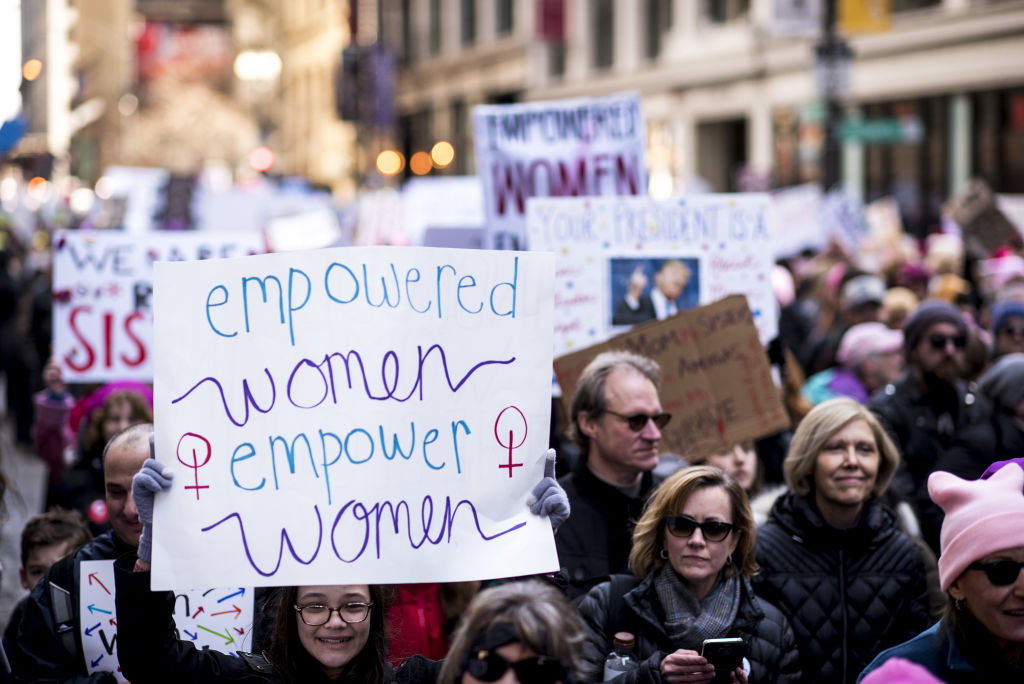
On Wednesday, after a disappointing showing in the Super Tuesday primaries,Nikki Haley—the first Republican woman to win a presidential primary contest—announced that she is suspending her campaign. When she does, some will no doubt remember her, as an article in the conservative National Review suggested, as “an example of female empowerment.” But she’s certainly not alone. In just the first week of February, Tulsa, Okla., held a “celebration of female empowerment”; Woman’s Day magazine featured “women empowerment songs”; and the Bechtel corporation announced its “pioneering women’s empowerment program” in Saudi Arabia. Now, with Women's History Month in full swing, examples of women’s empowerment are seemingly everywhere, appearing regularly in stories on politics, business, and popular culture.
A quick Google search of the term yields more than 17 million hits. Various websites list the “9 best charities for women’s empowerment,” “10 NGOs working for women’s empowerment,” and “11 Nonprofits that are advocating for female empowerment.” The United Nations has “Women’s Empowerment Principles” for equity in the workplace, and more than 8,000 companies have endorsed them. Empowerment has worked its way through American culture, from the halls of high politics to the entertainment world, where celebrities like Beyoncé and Taylor Swift win praise for empowering female fans.
Empowerment has become a ubiquitous buzzword in part because it’s hard to oppose it. It’s a slippery feel-good term that different people—with different goals—can adapt to their own agendas. It allows them to hint at progress for women without spelling out what that progress entails. It even lets politicians who most mainstream feminists would argue fail to champion women’s rights, such as Haley, bask in its popular glow.
A brief history of the word “empowerment” reveals that it dates at least to the 17th century. But despite its lengthy lineage, it rose to prominence surprisingly recently—in the 1980s—when psychologists announced an “empowerment model” and conducted, as one book title stated, “studies in empowerment.”
Their goal was to diminish the paternalistic control wielded by experts and instead nurture disadvantaged people’s participation in local politics. Empowerment was broad enough that it could manifest as an attitude, process, or behavior. It could register as an individual rejection of helplessness, development of acquired skills, or collective political clout in local urban elections. “Empowerment,” one psychologist wrote in 1984, was “difficult to define positively because it takes on a different form in different people and contexts.”
Read More: The Internet Has Thoughts on Ken Getting an Oscar Nomination Over Barbie
By 1990, “empowerment” had caught the eye of the lexicon maven William Safire, who featured it in his weekly column “On Language” in the New York Times Magazine. Safire described it as a newly “voguish political noun” with appeal across the ideological spectrum. He found it on the left, with roots in 1960s “power to the people” protest movements, and he saw it on the right, where Housing and Urban Development Secretary Jack Kemp, a prominent conservative (and later the Republican nominee for vice president), was, Safire claimed, “Mr. Empowerment” in the executive branch. Kemp’s version of empowerment was not the collective power of social movement protest; it was instead the power he found in tax cuts, private home ownership, and individual initiative in a free-market economy.
By the time Safire wrote his column, empowerment had worked its way into several specific contexts beyond national politics. Among Black activists, “community empowerment” signified local clout. The Brooklyn-based Coalition for Community Empowerment, for example, worked to elect Black candidates to office. The term “community empowerment” sometimes also referred to economic development, promoting Black-owned businesses in Black neighborhoods, and to citizen involvement in children’s education, public housing, and crime prevention.
Among management experts, “employee empowerment” had a very different valence. It was a way for supervisors to encourage their subordinates. It aimed to lift morale, motivate, incentivize, energize, and ultimately increase productivity. But it did so without fundamentally challenging the workplace hierarchies, or pay scales, in which subordinates were still subordinate.
By the late 1990s, there were, by one account, hundreds of publications addressing employee empowerment, and numerous corporations—Polaroid, Boeing, Visa, and United Airlines, to name a few—had adopted employee empowerment practices. These usually involved teamwork and a minor modicum of shared decision-making. By that point, critics saw the empowerment programs as “nothing more than a new form of exploitation” by management, in which employees had “no real control” over their work. The programs were a corporate mandate, issued from the top, where management retained control even as it preached empowerment and pretended to share authority.
Today the phrase “women’s empowerment” has eclipsed “community empowerment” and “employee empowerment.” It, too, came to prominence in the 1980s and 1990s.
In international development circles, it was part of a larger movement that sought to include impoverished women in economic programs that had previously ignored them. Left-feminist networks in the global South, such as DAWN (Development Alternatives with Women for a New Era), saw democratic grassroots organization among the poor and marginalized as the key to women’s empowerment. They showcased groups like SEWA (the Self-Employed Women’s Association) of Ahmedabad, India, a trade union for women street vendors, homeworkers, and others in the informal economy. But the language of empowerment spread quickly to technocratic bureaucracies, including the World Bank, where women’s empowerment was an add-on to top-down lending programs, offering tiny loans to women entrepreneurs.
Read More: To Zainab Salbi, Supporting Women Is the Key to Social Progress
By the 1990s the phrase cropped up repeatedly in English-language publications across the globe.
Today, as before, the concept of empowerment is malleable enough to take the shapes its advocates prefer. To some, it envisions women winning the power to challenge longstanding social hierarchies and achieve substantive equality. For others, though, it simply stands for giving women a sense of power—a morale boost sometimes framed as self-confidence—or a small loan or a low-paying job.

And the term’s ambiguity helps explain why women’s empowerment is still so frequently invoked. It can refer to the power women workers win through collective bargaining, or it can allude to the self-reliance of up-by-your-bootstraps mobility. It can also suggest that public attention to a prominent woman, like Nikki Haley, gives power to other women, even if it’s “a stripped-down brand of female empowerment.”
These multiple variants of empowerment, with their different visions, should remind us that empowerment’s positive gloss can obscure as much as it reveals. “Empowerment” only has meaning when we look beyond the buzzword and ask exactly how, who, and what it proposes to change.
Joanne Meyerowitz is Arthur Unobskey professor of history and American studies at Yale University and a public voices fellow of the OpEd Project.
Made by History takes readers beyond the headlines with articles written and edited by professional historians. Learn more about Made by History at TIME here. Opinions expressed do not necessarily reflect the views of TIME editors.
More Must-Reads from TIME
- Cybersecurity Experts Are Sounding the Alarm on DOGE
- Meet the 2025 Women of the Year
- The Harsh Truth About Disability Inclusion
- Why Do More Young Adults Have Cancer?
- Colman Domingo Leads With Radical Love
- How to Get Better at Doing Things Alone
- Michelle Zauner Stares Down the Darkness
Write to Joanne Meyerowitz / Made by History at madebyhistory@time.com
